
The online database, Trading Economics, indicates that in June 2023 the global price for lithium had risen to $59,212 per tonne. But by November it had fallen by more than half to $27,218. Prices have continued to plummet. As of December 31, lithium was selling for just $18,242 per tonne.
How could this be? Electric vehicle (EV) mandates established in many rich developed countries over the past few years had analysts predicting that if targets were actually met, the world would need 388 new lithium mines by 2035. A Fraser Institute study suggests that getting enough mines built to satisfy all the mandates will be a problem. It takes from seven to ten years to get a mine financed, approved and built.
Canada’s Environment Minister, Steven Guilbeault is certainly trying to drive up demand for lithium. The federal government’s Zero Emissions Vehicle Standard insists that by 2030, 20% of all new passenger cars, SUVs and light trucks sold in Canada must be greenhouse gas emissions free. New battery plants are being handsomely subsidized in Canada to power all of the new electric cars that will presumably be required. With similarly aggressive mandates in Europe and US states led by California there should be heavy demand for lots of batteries and a mountain of lithium.
The most likely explanation for collapsing lithium prices is US consumers’ reluctance to embrace electric vehicles. The Economist reports that EVs accounted for just 8% of new vehicle sales in America this past year. GM was only able to sell 20,000 EVs, but it did manage to sell over half a million fossil-fueled vehicles. Disappointing demand for EVs prompted GM to shelve plans to spend $4 bn to convert one of its plants to electric pickup truck production. Ford has similarly lost enthusiasm for EVs. This past fall it decided to delay plans to invest $12bn in EV production. Companies that make lithium batteries for EVs have responded accordingly. This past fall battery plants in Georgia and Michigan laid off hundreds of employees. Fewer batteries translated into less demand for lithium.
It would appear that EV adoption goals established under Joe Biden’s eye-wateringly expensive green transition initiative (disguised as the “Inflation Reduction Act,”) are not being met. The Biden plan offers tax credits of up to $7,500 for people who purchase EVs. However that hasn’t been a sufficient sweetener. The average EV sold in the US has a $52,000 price tag and that doesn’t account for additional costs like wiring a home charging set up. California, Florida and Texas account for over half of US EV sales and are also responsible for high average sticker prices. Ostensibly virtuous EV buyers in the US have a bit of hypocrisy going on. They’ll happily drive EVs as long as they are full size SUVs. Batteries are heavy which makes EVs heavier than gas and diesel fueled vehicles. And, electric SUVs are especially heavy—heavy enough to increase the chances of deadly collisions. Tesla has apparently created a super-sized SUV, designed for wealthy California drivers, that makes the Hummer look like a toy. And, because they are extra heavy, driving them uses more electricity and it takes extra energy and materials to build them. Furthermore, given that fossil fuels still account for 60% of the electricity generated in the US, EVs are less environmentally friendly than advertised. They are far from being “emissions free.”
EVs are indeed more popular in Europe and China. In Europe 1.5 million EVs were sold this past year and 3.5 million were sold in China. The models sold in China are small, zippy units that don’t weigh much. However, like in the US, around 60% of the electricity consumed in China is generated by burning fossil fuels (mostly coal).
Despite having a copycat EV mandate that mirrors those in Europe, Canadian sales have been even less stellar than what the US has been able to achieve. In 2021, EVs accounted for just 5.3% of new car sales in Canada. Most of them were sold in Ontario, BC and Quebec (55,229) which makes sense—those are the provinces where most Canadians and most climate-alarmed Canadians live. In all the rest of Canada just 7,301 electric vehicles were purchased.
Clearly, the adoption of electric vehicles has failed to meet the overly ambitious targets set by environmentally-friendly policy makers. This result lines up with the litany of missteps and missed targets that have plagued green transition projects over the past two years. The failures include the big decline in demand for new solar and wind power projects and the reversal of greenhouse gas emissions reduction projects in the UK and Europe. An issue this could raise for us in Canada is that Steven Guilbeault might see the international data and worry that his transition plans need to be beefed-up. He could make them even more onerous, expensive and ludicrous.



